Five card poker is a term often used to refer to five-card draw poker and five card stud poker. These are very different games. This guide includes the rules, and some strategies, as well as on some standard variations of each.
We will begin with Five-Card Draw Poker.
It is one of the earliest and simplest variants of poker. Five Card Draw is rarely played in brick-and-mortar casinos, though it can occasionally be found online at PokerStars and other large poker sites.
It and some variations remain popular in some home games; it was once the dominant poker game in the United States, especially in public card rooms in California.
In this guide, pro poker player Ashley Adams will cover:
Then, we will move on to 5 Card Stud Poker and discover:
Without further ado, let’s get started!
Ever heard of Five Card Draw Poker? It's a classic! You get dealt five private cards and the game begins with a betting round, just like in Texas Hold'em.
But here's the twist: you can swap out any of your cards after the first betting round to try and improve your hand. This is why it's called 'Five Card Draw'.
Now, imagine you've swapped your cards and another round of betting follows. If you're still in, you'll reveal your hand during the showdown.
The player with the highest-ranking poker hand takes the pot.
Remember
It's less about the cards you've got and more about what you decide to do with them. It's all about strategy and reading your opponents.
Five Card Draw itself has many variations. Traditionally it is played with the highest hand winning the pot.
But there are also several variations with the lowest hand winning (Lowball) and variations with the high and low hand splitting the pot (Archie).
The game can be played with a single draw, as is done traditionally, or with multiple draws, with the triple draw variation being the most common.
The game may be played as a limit game (the most common), or as a pot limit or no limit game.
Over the many decades that the game has been played, players have created dozens of additional variations involving common cards (Spit in the Ocean being the best known), wild cards (Deuces Wild being the oldest), and non-traditional hand value games like Badugi.
Fun fact
In recent years, draw poker games also feature prominently in split pot games and mixed games, especially mixed games with many poker variants like 12-game mix. We will cover some of the more popular forms of those variants here.

“Draw”, as Five Card Draw is generally referred to, began in the antebellum United States, as one of the first variants of poker. Its popularity spread nationwide during the Civil War, as soldiers who played it in camp brought it home to their friends and family in cities and towns across the United States.
It is the variety that is featured in many Westerns and other movies set in the Old West.
In the 1930s, Draw Poker was deemed by the courts in California to be a game of skill, and as such could be legally spread in public card rooms there, even as other forms of poker, like Stud, Omaha, and Texas Hold’em, remained illegal. This increased the popularity of Draw Poker.
Five Card Draw remained an extremely popular poker variant, typically the first form of poker people learned, up through the 1980s.
By that time, other forms of poker, notably Seven Card Stud, Hold’em, and Omaha, began to take hold as more popular poker variants. In the late 1980s, when California deemed all forms of poker to be legal in that state, Five Card Draw quickly faded in popularity everywhere.
Today it is rarely spread in public poker rooms, though Lowball, a variant of Five Card Draw, where the “worst” hand wins, is still occasionally played, especially in mixed game tournaments.
You can also still find Five Card Draw and Lowball in online games at some online poker rooms including PokerStars.
At its core, Five Card Draw is an extremely simple game. It has just two betting rounds.
Each player is dealt five cards, one at a time, face down. Hands are dealt and bet clockwise. There is a round of betting, beginning on the dealer’s left. After the round of betting, players may replace any or all of their five cards. This is followed by the second and final round of betting, also beginning on the dealer’s left.
Players remaining in the hand at the conclusion of the betting then compare their hands, with the high hand winning the pot.
If one player bets and is not called, the bettor is awarded the pot without having to reveal their cards. If all players check, the hands are revealed, and the high hand wins the pot. If players have exactly the same hand (a very unusual occurrence in this game), the pot is divided between or among them.
Simple, right?
While Five Card Draw always involves a deal, a draw, and two betting rounds, other details of the game affect strategy and must be addressed before exploring the finer points of strategy.

Let’s explore the difference between antes and blinds:
Blinds
When casinos spread Five Card Draw, they typically play it with a small and big blind (and sometimes a third blind as well), as in Texas Hold’em and Omaha.
Before the cards are dealt, the first player to the left of the dealer, known as the small blind, begins the betting round with a small forced bet. This is followed by a larger forced bet, typically double the smaller bet, by the player to their left, known as the big blind.
Thereafter, players must either call the blind, raise it, or fold. If no one raises the blinds, then the blinds have the option of raising when the bet comes back around to them.
Antes
Many home-game players play the game with antes instead of blinds, with each player posting a small amount of money that’s put into the pot, before the initial cards are dealt. (In some ante games, the dealer posts the collective antes of all players).
In those ante games, the player to the immediate left of the dealer may begin the action with either a check or a bet.
If they begin with a check, the option to bet or check proceeds to the next player to their left. This option continues as players check until one player initiates the action by making a bet.
If no player opens the betting, the game proceeds to the draw phase without a bet being made. Once a player opens the betting, the action proceeds as it would in the blind game, with subsequent players having the option to call the bet, raise the bet, or fold. (Many prefer this option, as it speeds up the game and obviates the need to make sure each player has posted their ante.)
Strategy Considerations of Blinds vs. Antes
The game with blinds increases the action of the game, as it eliminates the option to check on the first round of betting.
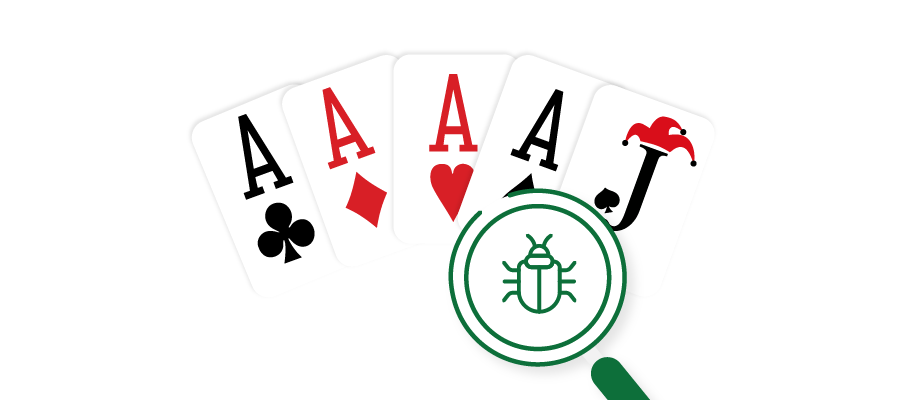
Some Five Card Draw games are played with a Bug. A bug is the Joker, added to a standard 52-card deck as a 53rd card. It serves as a limited wild card. It can either be used as an Ace or to make a straight or a flush.
Hence, As, Ah, Ad, Ac, Joker is 5 Aces, the best possible hand and beating even a Royal Flush. Joker, Ks, 9s, 5s, 2s is a flush.
For purposes of comparing flushes, the Joker counts as a zero, below the 2. So the Ace-high flush of Ad Qd 7d 3d 2d would beat the King-high flush: Joker, Ks, Qs, 8s 5s. Jd 9s 8s 7c Joker is a straight.
The only exception to this is if the Bug would complete a Royal Flush as the Ace of the suit. It may fill that role as well.
Strategy Considerations of the Bug
Adding a bug definitely increases the volatility of the game, as it allows players to make stronger hands.
Having the bug in your hand is a decided advantage, not just because it gives you more ways to make an extremely strong hand, but because it means that no one else has the Bug.
What limit?
Five Card Draw can be played limit, no limit, or pot limit. The limits may be anything from $.01/.02 to as high as you can imagine. I know of limit Draw games as big as $100,000/$200,000. There are only two betting rounds in Draw. The betting limits of each of those two rounds tend to be greater than those in Hold’em, which has four betting rounds, or Stud, which has five betting rounds.
When Draw is played limit and with blinds, the small blind is typically half of the lower tier of the limit, and the big blind is equal to the small tier of the limit. Hence, in a $10-20 limit draw game, the small blind would be $5 and the large blind would be $10.
When the limit game is played with antes, the antes would typically be 10% of the small blind. In a $10-20 game, for example, the ante would typically be $1.
When Draw is played no limit or pot limit, the stakes are typically defined by the size of the blinds and the maximum buy-in, as in Hold’em or Omaha.
These blinds can also be either extremely low, as with a small blind of $.01 and a large blind of $.02, or as high as anything you can imagine.
Pro tip
Some no limit or pot limit games also will add a third blind, often called a straddle, either in sequence after the big blind, or on the button. In some games, these additional bets before the cards are dealt are voluntary; in others they just function as a required third blind.
Whenever playing no limit or pot limit, you want to be certain that the game is played with table stakes.
This means that no one may bet, or be required to bet, more than the total amount in front of them during the play of the hand. If, for example, a player bets $100, and his opponent only has $20, the opponent may call the $100 bet.
The short-stacked opponent is considered all-in, and may only win the amount for which they have called – specifically in this hand $20.
No one can be “bet out of the pot” because they don’t have enough money to call the full amount of the bet.
Similarly, in a table stakes game, no one can go into their pocket, go light, or otherwise owe the pot for any amount of money that they don’t have in front of them.
When played in a casino or other public poker room, players may draw 1,2,3,4, or 5 cards.
You want to draw all five, and get an entirely new hand? No problem. Draw five.
In private games, however, where players make up their own rules in their house or club, there is often a limit on how many cards may be drawn.
Typically, home game players will limit the draw to no more than three cards, or four if you have an Ace. Make sure you know the rules of the establishment in this regard before you play your first hand.
If the dealer will run out of cards before every player gets their complete draw, then the discards are shuffled and the draws will come out of the shuffled discards.
For this reason, if playing with six or more players, when running out of cards may be a problem, it is prudent to ask players how many cards they are drawing, to see if you will have enough cards for all replacements, before replacing anyone’s cards.
Let’s explore some additional versions of 5 card draw:
Jacks or Better (Jackpots)
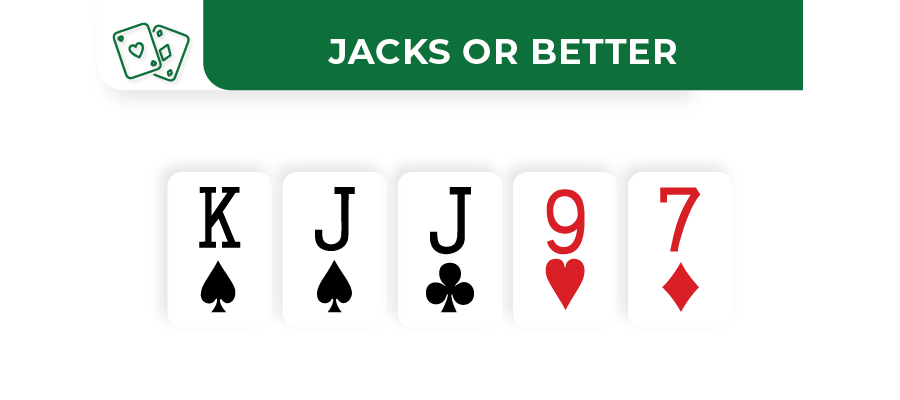
Draw games are sometimes played with a minimum hand for opening the betting. This is most often a pair of Jacks. “Jacks or Better” became an extremely popular form of the game. This is sometimes the game when it is called in a home game.
This game variation is simple.
You must have a pair of Jacks to open the betting before the draw. You cannot bet with only a pair of Tens or worse. If you open the betting, you may be required to show your pair at showdown even if there is no caller.
Any player at the table may ask to see your openers.
Splitting Openers
Sometimes, when playing Jacks or Better, a player holding a four-flush or a four-straight as well as a pair, elects to discard one of the paired cards and draw one card.
This is known as “splitting their opener”. When this is the case, the player may have their discard held to the side, to be available for inspection once the hand is completed, to ensure that they did in fact have the requisite pair.
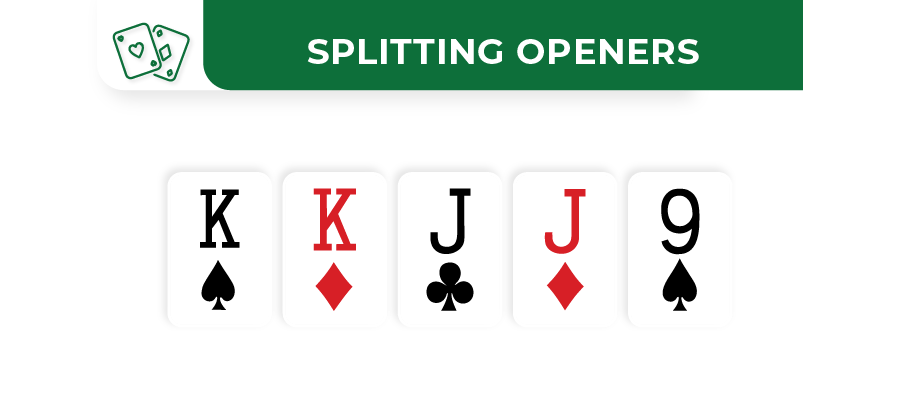
Pro Tip
The Jacks or Better rule may seem like a method for keeping recreational players from playing too loosely. Since they may not open with anything less than Jacks – smaller pairs or just high cards for example – they are forced to apply certain standards to their play – that is to say they must play more tightly than a recreational player might typically play.
In fact, however, the introduction of the “Jacks or Better” rule typically leads to bad players playing more “incorrectly”. Though, by rule, they may not open with less than Jacks, a recreational player may incorrectly feel compelled to open with a pair of Jacks or better – which they then do.
This is typically an error – as we’ll see in our strategy discussion of the game. Though they may open with a pair of Jacks in Jacks or Better, it is often a mistake to do so.
Lowball Five Card Draw Poker
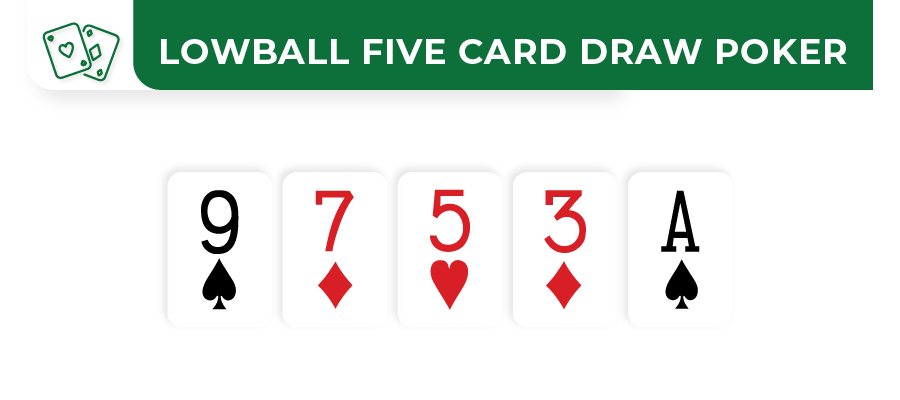
Lowball is a variation of Five Card Draw that was probably developed by some poor soul who was tired of getting bad cards all night.
They probably figured to take advantage of their bad cards by declaring that in this variation, the worst hands would win!
Pro Tip
In Lowball, hands are referred to by their highest card. So, for example 9 7 5 3 A would be referred to as a 9 low, or a 97 low. A very good low card is referred to as smooth. So 8 4 3 2 A would be a “smooth 8”. A bad hand is referred to as rough. So 7 6 5 2 A would be called a “rough 7”.
A typical exchange about a Lowball hand might be something like this. “I had a rough 6 draw; and you had a made 7 smooth. Naturally, I took one off. I drew an 8. And you stood pat and beat me. Tough game, Lowball!”
In fact, Lowball is as skillful and strategic a game as its high-card sibling.
It has a reversed hierarchy of hands, placing hands with no pair ahead of a hand with a pair or better. Lowball itself has a few variations that center on what exactly the best hand is in this game.
These variations are:
California Lowball
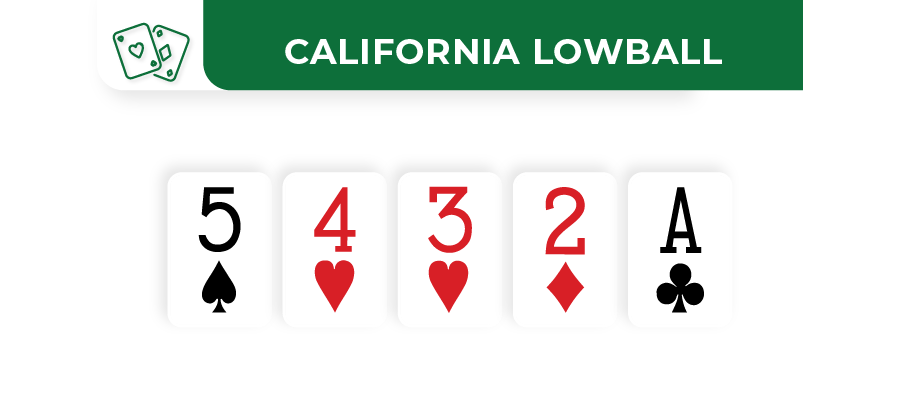
Also known as A to 5 Lowball, it values the “Wheel” A,2,3,4,5 as the best hand. It discounts the value of all straights and flushes, judging the winning hand as if straights and flushes don’t count as high hands.
Top Six Hands in California (A to 5) Lowball
- 5 4 3 2 A
- 6 4 3 2 A
- 6 5 3 2 A
- 6 5 4 2 A
- 6 5 4 3 A
- 6 5 4 3 2
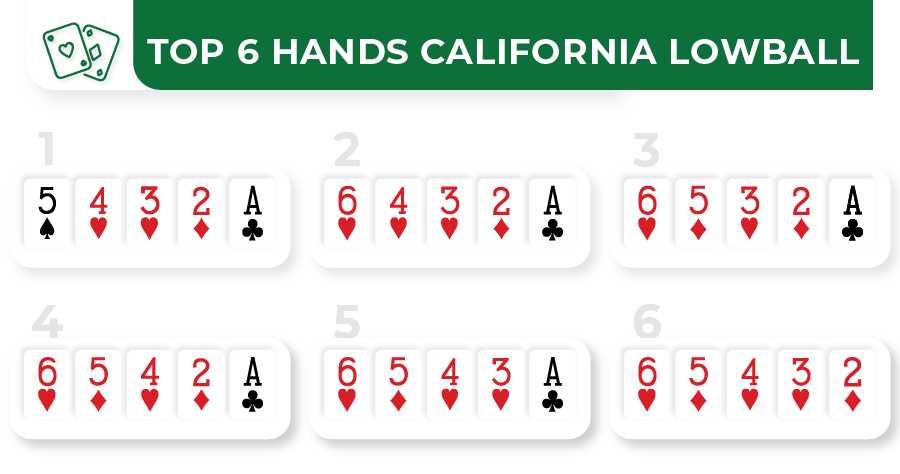
6-4 Lowball
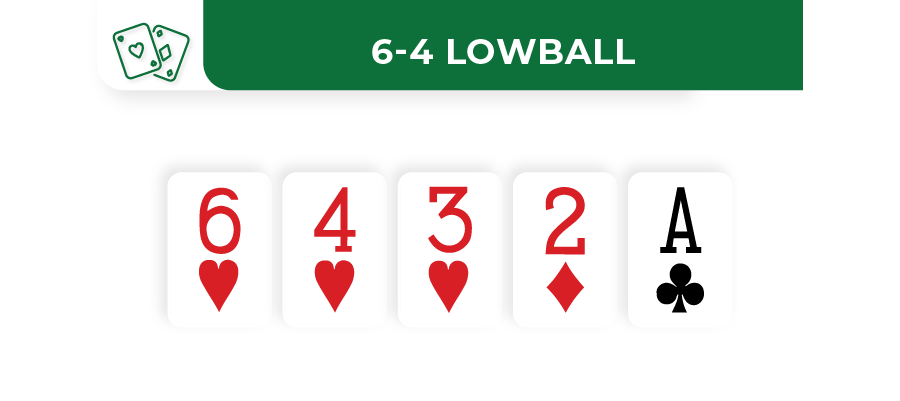
This is a very common home game version. It ranks 6,4,3, 2, A of mixed suits as the best hand.
The wheel is not a good low hand in this variation of the game. It is considered a straight – a very bad low. Five suited cards are considered a flush – also a very bad hand in this version of the game.
Top Six Hands in 6-4 Lowball
- 6 4 3 2 A
- 6 5 3 2 A
- 6 5 4 2 A
- 6 5 4 3 A
- 7 4 3 2 A
- 7 5 4 2 A
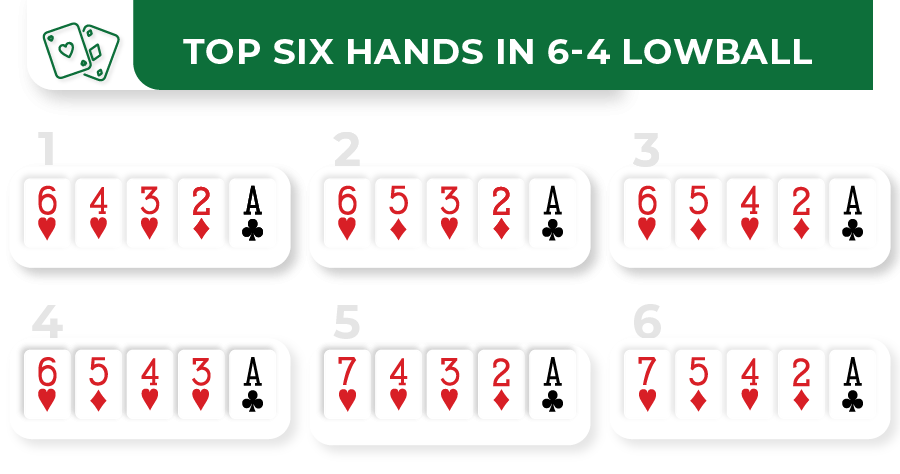
Kansas City Lowball
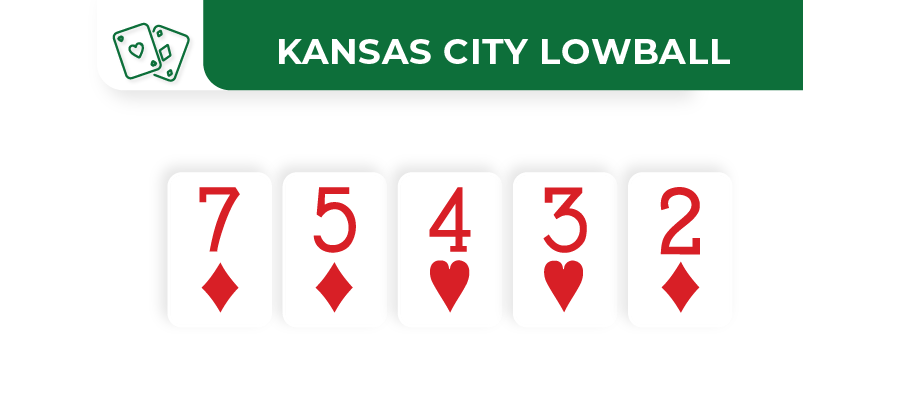
Also known as Deuce to Seven Lowball, this deems the 2,3,4,5,7 as the lowest possible hand.
Straights and flushes are considered high hands, and the Ace is considered as a high card, making any hand with it a very bad hand in this version of the game.
A Wheel, A 2 3 4 5, would be considered a straight. And A 2 3 4 6 would be considered an Ace-high and would lose to King-high in Kansas City Lowball.
Top Six Hands in Kansas City Lowball (Deuce to Seven)
- 7 5 4 3 2
- 7 6 4 3 2
- 7 6 5 3 2
- 7 6 5 4 2
- 8 5 4 3 2
- 8 6 4 3 2
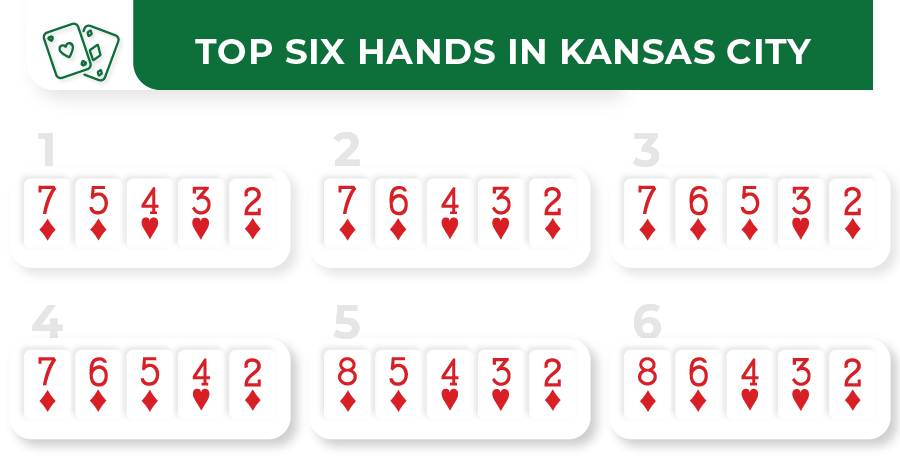
Lowball, in any of its variations, is dealt and bet exactly as the high version of the game. It may be played limit, pot limit, or no limit, and the stakes may be as varied as in Draw.
In California Lowball there is often a “Bug” that may be used as any low card to make a low hand.
Having the Joker greatly increases the strength of a drawing hand.
A drawing hand like Joker K 5 3 2 is much stronger than K, 6, 5, 3, 2, for example. In the former instance, with the Joker and three babes (low cards), any of 12 cards (4, 6, or 7) gives the player a strong hand.
In the later, without the bug, the draw looks good, but there are only four cards, the four 7s that make the good low hand.
A 4 makes a straight, a 6, a 5, a 3 or a 2 make a pair.
Also, when you have the bug, you know that none of your opponents have it – adding to the strength of your draw.
Multiple Draw Variation (i.e. Triple Draw)
Five Card Draw has traditionally been played as a single draw game. However, Lowball is now often played as Triple Draw, with two additional drawing and betting rounds.
Players ante and/or post blinds, get dealt their initial five cards, bet, draw, bet a second time, draw a second time, bet a third time, draw a third time, bet a fourth time, and then have a showdown.
The most common version of this game is “Deuce to Seven Triple Draw”. This game combines Kansas City Lowball with Triple Draw, giving players three opportunities to draw. The 7 5 4 3 2 is the best possible low in this game.
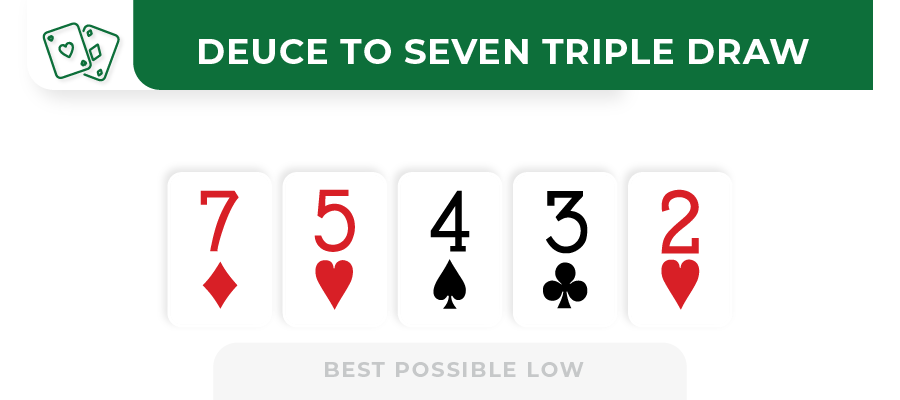
Pro Tip
When playing “Deuce to Seven Triple Draw” you should generally not bet the hand or call a bet unless you have a 2 in your initial five cards.
High-low variation: Archie
An increasingly popular version of Five Card Draw is called “Archie”.
This is a split pot game, with the low hand, which is the best Ace to Five Lowball hand, splitting the pot with the best high hand, which is the best Five Card Draw hand. It is usually played with qualifiers for both high and low.
To win the low hand, the low must be at least an 8 low. To win the high hand, the high hand must be at least a pair of 9s. (Some variations raise the low qualifier to a 9 low; other variations lower the high qualifier to a pair of 6s).
In this variation, if no player qualifies for low, then the high hand wins it all. Similarly if no player qualifies for high, then the low hand wins it all.
If no player has either a qualifying low or high hand, then the pot is split between or among all players remaining at showdown.
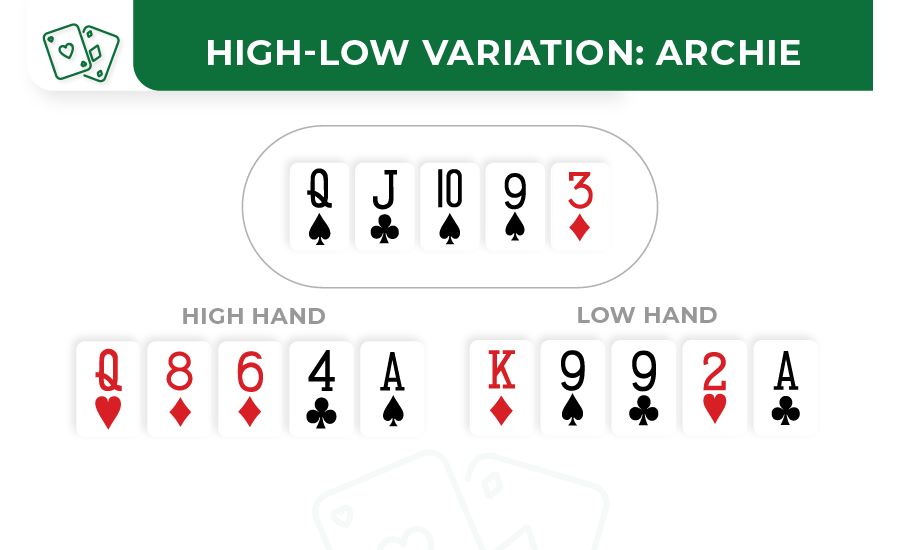
Archie is typically played “cards speak”.
The highest qualifying hand at showdown splits with the lowest qualifying hand at showdown. Players do not have to declare which way they are going.
However, when Archie is played in home games, players sometimes play it with either a simultaneous or a sequential declare. A sequential declare has each player, beginning to the left of the dealer, declare whether they are playing for high, playing for low, or playing for both.
This gives the dealer an enormous advantage, as they get to see how others are declaring before they have to declare.
The more common variation is to have the declarations made simultaneously, with players placing one chip in their closed hand if they are competing for low, two chips for high, and three chips for competing for both high and low.
Sometimes, in this version of the game, there is also a rule that if you want to win with a high and a low declaration you must in fact win both high and low outright – without tying.
Other variations allow players who declare both but then tie in one direction to split the side of the pot in which they tie. Make sure you understand the rules before you compete.
Five Card Draw strategy, like all games, comes down to a combination of playing the percentages and playing the players.
What follows are some very basic and simple tight and conservative strategy guidelines that should keep you out of trouble as you figure out the betting proclivities of your opponents.
Five Card Draw (high only) Strategy
The high-only strategy for five card draw goes as follows:
Draw is a positional game. With no exposed cards, and with the betting option always beginning to the dealer’s immediate left, those in later position retain a decided advantage for both betting rounds.
If you are playing dealer’s choice, with each dealer calling the game he deals, you are well served to call a draw game.
Your position works in your favor in three ways: you get to see your opponent’s initial betting action before you have to decide how to bet; you get to see how many cards they draw before you decide how many cards to draw; and you get to see your opponent’s betting action on the final round of betting before you decide how to bet on the final round.
Each of these three decision points works to your positional advantage. In general, you need higher standards to open the betting in early position.
Typically, you’ll want to have at least Kings or Aces to open, even if the game is Jacks or Better and you can open with Jacks or Queens. It doesn’t usually make sense to open with a pair of Jacks or Queens, as those after you, aware of your betting restrictions, won’t play against you unless they have at least Kings or Aces themselves.
While it’s true you could improve to trips or two pair on the draw, so could they. And if you improve to Jacks or Queens up, they may well improve to a better two pair.
Similarly, in middle position, you should generally not play hands in an opened pot with less than Kings. If the pot has not yet been opened, you could raise with Queens; but be wary of someone reraising you. Unless they are on a bluff, they are almost surely ahead of you.
You want to re-raise a raiser, generally, if you have Queens up or better.
Your lower two pair are unlikely to improve on the draw (you’re bucking roughly 12 to 1 odds against improving).
With two low pair, your opponent, with what is a pair presumably higher than either of your pair, will improve to a higher two pair than yours roughly 30% of the time if he draws three, and roughly 25% of the time if he draws two (as with an Ace kicker).
If you think your raise will knock out your opponents, you might try it; but with two or more opponents you will often end up second best if you don’t improve.
From late position, especially on the button, you can raise an unopened pot with just your Jacks.
But if they remain unimproved, don’t bet them after the draw if the hand is checked to you. You will rarely get any action on weaker hands; and you may well be against someone with two low pair or Queens or better.
After the draw, you generally want to be aggressive with your hand, while remaining aware of your opponent’s likely holding based on their draw, their betting action, their image, your betting action, and your image in their mind. If that sounds like a lot to be thinking about, you’re right. No one said playing winning poker was going to be easy.
How many should you draw?
Generally, you want to draw the maximum number of cards to fill your hand. With a pair, tend to draw three; with two pair, draw one; with trips draw two; and with four to a straight or four to a straight, draw one. Even so, there are times when you want to switch things up.
For the sake of deception, you should occasionally draw two to a pair, especially if you have an Ace as your third card to hold. Similarly, you may on occasion want to disguise your trips by only drawing one card, making your opponents think you are drawing to two pair or to a straight or flush. And then there are the times when you want to represent great strength, and you stand pat on any hand, drawing no cards, and betting strongly as if you have a made hand before the draw.
One last consideration
Few people play Five Card Draw these days. Fewer still are playing at the level of expert – as the game just isn’t spread very often.
Your money in this game will chiefly be made from bad players, playing too loosely, unable to resist the temptation to call and see what you have.
Accordingly, don’t waste much time and energy making extremely clever plays meant to deceive good players. Instead, concentrate on losing little by folding when you don’t have a strong hand, and betting aggressively when you judge your hand to be best.
You’ll tend to win more money from bad players chasing you than from good players who are fooled by your cleverness.
Now let's explore the ins and outs of Five Card Stud Poker.
This game is dealt and played similarly to its more popular young brother Seven Card Stud, but with two fewer cards.
Five Card Stud can be played limit, no limit or pot limit, though the most common variant is limit.
The game is now generally played with an ante (though it used to often be spread with no ante and no blinds). The ante is posted by each player and is usually 10% of the smaller tier bet. In a $10-$20 the ante would be $1. In some circles the ante is posted by the dealer for all players.
Thus, in an eight-handed $10-$20 limit Five Card Stud game, the dealer would ante $8.
With the deal passing each hand, this evens out in the end and saves considerable time and energy chasing people for their antes.
After players ante, the dealer deals each player one card face down (known as the “hole card” and then a second card face up (known as the “board”). The board card is required to start the betting on the first round with what is known as the “bring in” bet, usually a third or so of the amount of the initial bet. In a $10-$20 limit game, the bring-in is typically $3.
Thereafter, during the first round of betting, players may call the bring-in, complete the bet to the full bet amount, or fold. Once the bet has been completed, it may be raised in increments of the small bet.
For example
If player A brings in the bet for $3, and player B completes the bet to $10, player C may raise the bet to $20, and player D may raise again to $30, and player E may raise again to $40.
Typically, there is a limit of a bet and three raises, making the raise to $40 the last allowable raise. Thereafter players may either call the $40 or fold.
All players remaining at the end of the betting on the first round receive a fourth card, upon which the highest hand showing has the option of initiating the betting.
Bets are still of the lower tier.
In a $10-$20 game they remain at $10. The highest hand showing may bet $10 or check.
If they check, the option to bet passes to the player to their left, continuing around the table. Once a player makes the initial bet, other players may either call, raise, or fold.
In this way, betting progresses to each betting round, until the third and final round of betting, when all active players have one down card and four up-cards. This last round of betting is known generally as “The River”.
At the conclusion of betting on the River, all remaining players face their cards, with the highest five card poker hand winning. Suits do not count. The highest poker hand wins. In the extremely rare event where two or more hands tie, the pot is divided equally.
As a reminder, here are the hand rankings in poker:

The five card stud comes with a set of additional rules:
Paired Door Card
On the second round of betting, when the second up card is dealt, if the card matches their first card (known as a “door card") giving them an exposed pair, they have the option of betting the higher tier of betting.
So, for example, in a $10-$20 game, a player with an exposed pair may begin the betting by betting $20 instead of $10. If they elect to bet the higher tier amount, then all subsequent bets or raises must be in by that amount.
Players either call $20 or raise to $40. And if the pot has already been raised to $40 they may raise to $60. You may not raise or bet by $10 once the option to bet or raise by $20 has been taken.
On the other hand, if the first player to act, who has an exposed pair, elects to bet the lower tier (in this example $10), then the next player may raise by $10 or $20. Once the $20 amount has been bet or raised, the play continues at the $20 level until the end of the hand.
Exposed down-card
If a down-card is exposed during the first round of dealing, it remains as an exposed card. The second card that player receives must be a down-card. It is not a misdeal.
Tied door cards
If there is a tie in the lowest door-card on Third Street, the card with the lower suit (suites rank, from highest to lowest, spades, hearts, diamonds, clubs) has the option to begin the betting.
For example
One player has the 2d and the other the 2s, the player with the 2d must post the bring-in bet (or a complete bet if they wish to do so).
On subsequent streets, if the two or more players have the exact same exposed hand, then the betting option commences with the player closest to the dealer’s left.
In the event two hands tie at showdown, the pot is divided. In the case of a flush, the suit does not matter. If the flushes rank as equal, regardless of which suit they have, the pot is divided.
The strategy of Five Card Stud, at its most basic, is very simple. When you have what you gauge to be the better hand, play aggressively and make your opponent pay to draw a hand that can beat you. When you are drawing, look for situations where you can draw profitably, when the pot odds offer you a sufficient price to make your draw. If you are not getting the proper price for your draw, fold.
You also want to be aware of situations when your opponent can be certain that he is ahead; and not bet into those situations. Let an opponent bluff into you; but don’t be unwise enough to bet into a hand that can be certain of being ahead. Here are a few illustrations.
Imagine you have the following hand on the river.
Your opponent has been representing a pair of Aces from the beginning; and you have been calling along.
On the first round of betting you had the following:
You (7h) 7s | Villain (?) As
Your opponent bet and you called, believing he was bluffing without a pair of Aces.
On the second round of betting you had the following:
(7h) 7s 8s (?) As 2c
Your opponent bet and you called.
On third round of betting you had the following:
(7h) 7s 8s Kd (?) As 2c 2d
Your opponent bet and you called.
On the river you had the following:
(7h) 7s 8s Kd Kh (?) As 2c 2d 6s
You are high on board.
Recommendation
Don’t bet this hand even if you think your opponent does not have the Ace. What would be the point of betting? He will not call your bet if he doesn’t have the Ace or a 2, as he’ll know he is beaten. Similarly, if he does have the Ace or a 2 he will almost certainly raise you.
You’ll probably have to call the raise, unless you are completely sure he isn’t bluffing, since you’ll be getting such large pot odds for your call.
You’re much better off to just check with your Kings up, and call if he bets, hoping he’s bluffing.
Other General Strategy Considerations for Five-Card Stud
To my knowledge, Five-Card Stud is not offered in public brick-and-mortar card rooms, not in cash games and not in tournaments. It may be offered somewhere on line, but I am not aware of any games currently.
That being said, it is played occasionally in home games – though often with some variations. I’ve listed some of the more common variations below.
For the most part, this means that when you are playing this game you will be playing with people who are recreational players.
Accordingly, you are generally better off playing straightforwardly – betting your good hands aggressively, making draws when you have sufficient pot odds to warrant the draw, and folding when you do not or when you have generally bad starting cards.
A good starting hand is a pair or, at the very least, a door-card that is backed up with an Ace in the hole. It usually is folly to play for a flush or a straight in five cards. The odds against it are prohibitively long.
The game is chiefly about betting high pairs aggressively, or convincing your opponent that this is what you are doing – getting them to fold. Card memory also helps, as your drawing odds, and the drawing odds of your opponent, are affected by the exposed cards, including the exposed cards that have been folded.
One last consideration – one that I hope doesn’t come into play in your game. With just one opponent’s card concealed, Five Card Stud is an ideal cheater’s game. Sneak a peak at an opponent’s down card and they are playing, literally, with their entire hand revealed.
If a savvy opponent calls Five Card Stud in a Dealer’s Choice game, I am at least initially on my guard – as, unlike games with concealed hole cards, like Five Card Draw, Hold’em, and Omaha; an honestly dealt Five Card Stud game gives no advantage to the dealer.
Here are some “home variants” of 5-card stud:
Five Card Stud – Last Card Down
You will sometimes find a game where the last card is dealt down instead of up.
This creates a lot of uncertainty, with 40% of the hand concealed instead of only one card hidden.
This is good and bad for the expert player, as you will be forced to rely on your sagacity in determining whether or not you are likely to have the winning hand. Certainty is usually preferred over vagary. But high variance often induces the less skillful to gamble, when they might otherwise retreat.
Five Card Stud – High Low
This also tends to increase the gambling quotient of the game, as recreational players figure they have a good shot of hitting one of two possible winning hands. If the game is played without a qualifier, the winning strategy is to play for low – as it sometimes hits a winning high as a straight or a flush or a pair of Aces.
But a good high hand has a much more difficult path for backing into a winning low hand.
Five Card Stud – Replacements, extra cards, common cards, and wild cards
There are a nearly endless variety of twists and turns that have been added to the straightforward game, in order to make it more interesting, fun, and less likely to be won by the hardnosed, grinding, tight aggressive player.
Some varieties allow players to exchange cards.
Others allow players to buy extra cards, or give all players extra common cards with which to make their hands.
Still other variations declare all Kings to be wild, or insert a Joker, or make the down card wild, or a common card and all like it in your hand wild. This can loosen players up, just as it may wildly increase variance and inflate the value of a likely winning hand.
Pro tip
The only one strategy recommendation I can make is to make sure you fully understand the variation. More than one skillful player has lost a big pot in one of these “crazy” games because he forgot to account for one twist or another.
Final thoughts
This marks the end of our 5 card poker guide.
By now, you should be familiar with all the different rules and variations of the game - 5 card draw poker and 5 card stud, and you are ready to get started!
Good luck and remember to check out the other guides in the Academy, you will definitely find some actionable insights to up your poker skills.

Bonuses
Casinos
Games
Academy
News
Shop
NEW Q&A
Sweepstakes


































